The D-backs’ Offense Can Still Improve
While the focus of the winter is clearly upgrading the pitching staff, it’s easy to forget about what the team did and can do at the plate. As we’ve said all along, they’re going to score runs, usually enough runs to win. Take a look around the lineup and it’s easy to see why. But that doesn’t mean there isn’t room to improve. Playing at Chase Field can help cover up some warts, and if there’s a sneaky way to improve the team, it might just be adding a dose of patience to the club.
Now let me just start by saying, this is tricky. When you suggest that a player alters his plate discipline you’re really taking a chance. Some guys who have traditionally bad plate discipline are still productive players. Adam Jones of the Baltimore Orioles has averaged 26 walks per season over his last five years. He’s also averaged 154 games played over those five seasons. He walks about once every six games, yet no one’s on him to improve his plate discipline because he’s produced offense at a rate 16% higher than league average during that time. Asking him to take pitches and take free bases would fundamentally change who he is as a player – he’s a aggressive and hits the ball hard. That’s who Adam Jones is.
But not everyone can pull this off. There are some special cases like Jones out there, but they’re the exception rather than the rule. Still, changing a player’s approach at the plate isn’t easy. This is a fundamental shift that may pay dividends over the course of a season, but from an at-bay by at-bat perspective, it might just seem like a waste of time. But just like ball beat the shift on occasion, we know that better plate discipline tends to lead to better offense. And here what I’m really referring to is pitches seen per plate appearance. Take a look at how pitches per plate appearance correlates to offense (defined as wRC+) for all hitters in 2015 with at least 250 plate appearances:
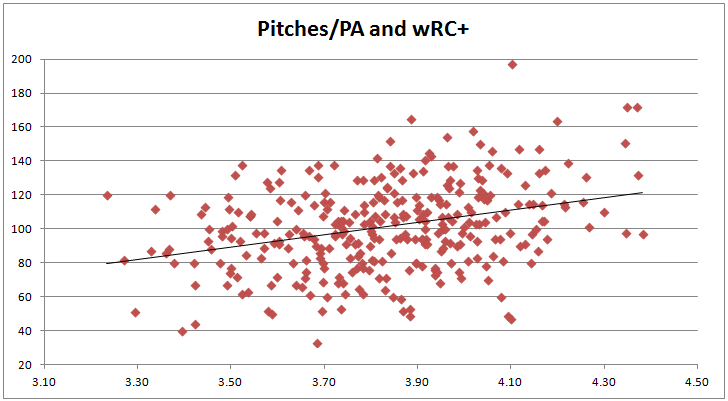 Maybe it’s not the most pronounced trend in the world, but clearly offense improves as pitches get seen. There are three reasons for this that jump out to me on first glance:
Maybe it’s not the most pronounced trend in the world, but clearly offense improves as pitches get seen. There are three reasons for this that jump out to me on first glance:
- Selection bias – better batters see more pitches because pitchers are less likely to pump fastballs repeatedly in the zone. They get pitched around in key situations and often have more opportunities to take walks thanks to pitchers wanting to live to face another (usually lesser) batter.
- Walking helps – taking free bases is a big part of offense, and that all gets wrapped up in wRC+. Seeing more pitches increases the odds of taking a walk (you need to accumulate four balls do so, after all) and that boosts the end result.
- Be selective – hitters who take more pitches give themselves more opportunities to receive a pitch over the plate that they can do damage against. They also force the pitcher to come over the plate if they’re willing to let pitches that are marginal pass (more on this in a minute). It’s the pitches in the zone that the batter should be feasting off of in the first place, so waiting to get one is a likely a good strategy.
So if we buy that seeing more pitches per plate appearance is a good thing for offense, then there are a couple of things you want to avoid. Swinging a lot is bad for taking pitches.
Swinging a lot at pitches outside the strike zone is really bad.
Remember that whole “be selective” part? Well, swinging at a bunch of trash outside the zone is basically the antithesis of that. And, as you can see, it generally doesn’t help offense:
That decline may not appear stark to the eye, but we’re talking about the difference between being an all-star and being a bench player here. By taking more pitches and, not-unrelated, swinging at fewer pitches outside the strike zone, we can expect an uptick in offense for most hitters. Again, I think making those changes sounds far easier than being the guy in the box tasked with implemented them. You’re asking a player to stop swinging at pitches he might normally and that adjusts the psyche of an at-bat. That said, it’s also not impossible to improve – you just have to be ready for mixed results, especially in the early going. And that might be something that the Diamondbacks should embrace, because:
Oh, hey there, the D-backs were third to last in pitches per plate appearance last season. They were second in total plate appearances, behind only the Pirates, but were in the middle of the pack in total pitches seen. They were also in the middle of the pack in offensive production when you filter out the effects of Chase Field. Clearly there’s room for growth as a team, but that growth is going to have to come from some very specific players. Only Paul Goldschmidt (4.20) and Jake Lamb (3.97) were above league average (3.80) in pitches per plate appearance. Welington Castillo was exactly average. The rest fell below:
Again, the cutoff here was 250 plate appearances, so we’re leaving out plenty of guys who just didn’t have enough chances to paint a clear picture. But with Nick Ahmed and Chris Owings making up 25% of your non-pitcher batting order, that’s going to take it’s toll. You might make an exception for a guy like Ender Inciarte as he’s found a way to barrel up baseballs all over the place. His hit tool simply exceeds those of Ahmed and Owings. Yasmany Tomas swung at absolutely everything in his debut and that’ll have to change in his sophomore season if he’s going to play any kind of prominent role.
I’m leaving A.J. Pollock alone now. I think he might just warrant his own piece…
But back to the topic at hand, can these guys make changes? Owings and Tomas are aggressive hitters. Ahmed is, kind of, but he was also just trying anything to survive. Some extra pitches seen might just give these players more opportunities to swing at pitches they can drive and/or take a free base more often, helping keep the line moving and giving the offense a chance to produce. The data suggests that this is worth trying and we’ll have to wait and see if a bit of increase plate discipline emerges as these players age and gain more experience in the batter’s box. Arizona can’t rely on Chase Field’s hitter-friendly environment to do all of the offense-boosting. They might be able to find some increased production internally by improving plate discipline next season. It’s a tricky maneuver, but it’s one worth trying.
12 Responses to The D-backs’ Offense Can Still Improve
Leave a Reply Cancel reply
Recent Posts
@ryanpmorrison
 Congrats to @OutfieldGrass24 on a beautiful life, wedding and wife. He deserves all of it (they both do). And I cou… https://t.co/JzJtQ7TgdJ, Jul 23
Congrats to @OutfieldGrass24 on a beautiful life, wedding and wife. He deserves all of it (they both do). And I cou… https://t.co/JzJtQ7TgdJ, Jul 23 Best part of Peralta’s 108 mph fliner over the fence, IMHO: that he got that much leverage despite scooping it out… https://t.co/ivBrl76adF, Apr 08
Best part of Peralta’s 108 mph fliner over the fence, IMHO: that he got that much leverage despite scooping it out… https://t.co/ivBrl76adF, Apr 08 RT @OutfieldGrass24: If you're bored of watching Patrick Corbin get dudes out, you can check out my latest for @TheAthleticAZ. https://t.co/k1DymgY7zO, Apr 04
RT @OutfieldGrass24: If you're bored of watching Patrick Corbin get dudes out, you can check out my latest for @TheAthleticAZ. https://t.co/k1DymgY7zO, Apr 04 Of course, they may have overtaken the league lead for outs on the bases just now, also...
But in 2017, Arizona ha… https://t.co/38MBrr2D4b, Apr 04
Of course, they may have overtaken the league lead for outs on the bases just now, also...
But in 2017, Arizona ha… https://t.co/38MBrr2D4b, Apr 04 Prior to the games today, there had only been 5 steals of 3rd this season (and no CS) in the National League. The… https://t.co/gVVL84vPQ5, Apr 04
Prior to the games today, there had only been 5 steals of 3rd this season (and no CS) in the National League. The… https://t.co/gVVL84vPQ5, Apr 04
Powered by: Web Designers@outfieldgrass24
 RT @OutfieldGrass24: What will MLB clubs do with their Rule 5 picks and what outcomes should they expect? The Rule 5 Draft happened a lo… https://t.co/s3TQkozdW7, 23 hours ago
RT @OutfieldGrass24: What will MLB clubs do with their Rule 5 picks and what outcomes should they expect? The Rule 5 Draft happened a lo… https://t.co/s3TQkozdW7, 23 hours ago RT @cdgoldstein: nice look from @OutfieldGrass24 here at why this year might see a disproportional number of Rule 5ers kept:… https://t.co/RYJUMedBZd, Jul 21
RT @cdgoldstein: nice look from @OutfieldGrass24 here at why this year might see a disproportional number of Rule 5ers kept:… https://t.co/RYJUMedBZd, Jul 21 What will MLB clubs do with their Rule 5 picks and what outcomes should they expect? The Rule 5 Draft happened a lo… https://t.co/s3TQkozdW7, 23 hours ago
What will MLB clubs do with their Rule 5 picks and what outcomes should they expect? The Rule 5 Draft happened a lo… https://t.co/s3TQkozdW7, 23 hours ago RT @baseballpro: Over a two-month season, rostering a Rule 5 draftee doesn't appear the commitment it would in a typical season. Wha… https://t.co/oDfD1Zq1vb, 24 hours ago
RT @baseballpro: Over a two-month season, rostering a Rule 5 draftee doesn't appear the commitment it would in a typical season. Wha… https://t.co/oDfD1Zq1vb, 24 hours ago Biggest takeaway from watching https://t.co/V9skCPImzi again: I apparently need Blue Emu in a bad way, Jul 20
Biggest takeaway from watching https://t.co/V9skCPImzi again: I apparently need Blue Emu in a bad way, Jul 20
Powered by: Web Designers

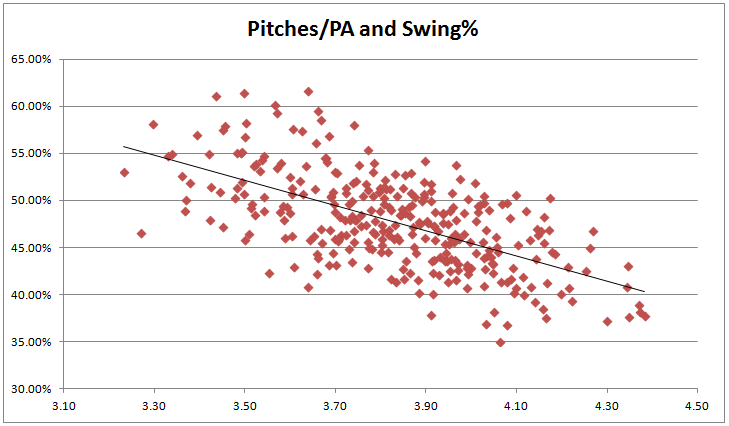

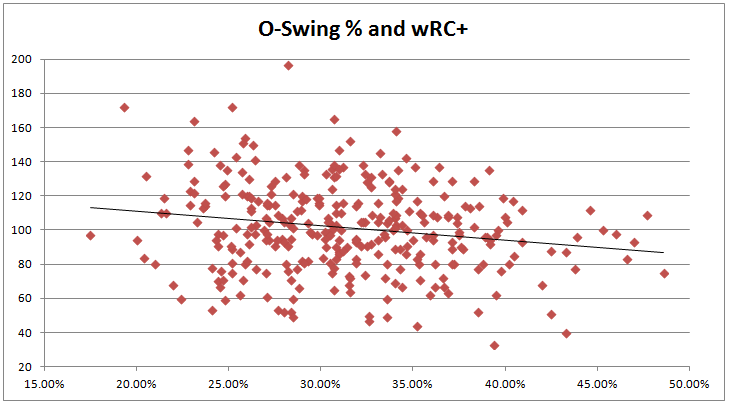
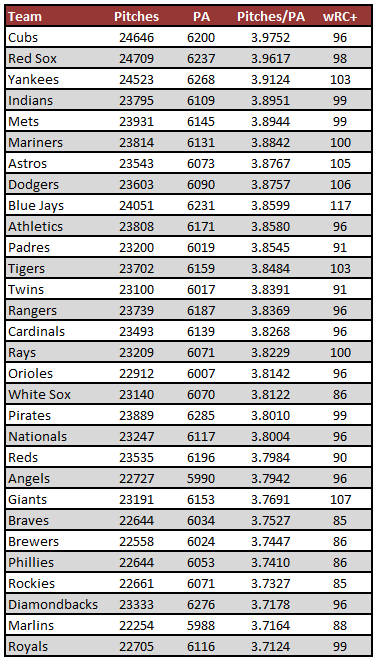
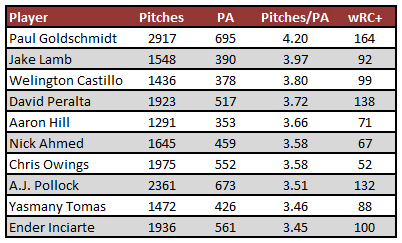




“Oh, hey there, the D-backs were third to last in pitches per plate appearance last season.” Yes, and DEAD LAST is the World Champion Royals. In fact, the difference between 1st and last on that list is .25 pitch per PA, or about 10 pitches a game. I wouldn’t even think that would be enough to make a difference except for the fact that all the rest of the teams on the bottom of that list were also the teams that were under 90 wRC+.
Still, a little plate discipline would be good for some of these guys. Maybe the new pitching coach…
Hi Rick, I’m sorry you didn’t like this post or the others you’ve commented on. Perhaps you have some other awesome research ideas for us. If so, please feel free to leave them here. Thanks.
I am so sorry if I have given that impression. I truly enjoy and like reading the articles on this site, which is the first place I go for DBacks commentary. I have commented three or four times where I wanted to add my take on what you were saying, but generally I see no need to comment cause I agree totally with your premises and conclusions.
All of you here keep up the great work.
Rick has a point though.
Its not simply a matter of taking more pitches, it is more a matter of swinging at strikes. KC did it to perfection in the World Series. KC hitters jumped on every pitch that was near the strike zone and gave the Mets All-Star pitchers fits.
I think this would help the team immensely, but in particular for Inciarte. Drawing more walks would take him from being a really good leadoff hitter to being one of the best in the game. He showed some improvement in August with a 9.3% walk rate, but his patience regressed again in September/October. If he does not improve it then no big deal he is still a really good hitter. It would just be nice to see him on base at a .350+ clip.
Inciarte, Tomas and Owings are at the top of D-Backs that need to take more pitches.
Owings has been this way his whole minor league career, so I just don’t expect that to change.
Tomas looks a lot like a Vladimir Guerrero or Pablo Sandoval, in that he is a free swinger, but he is also a “bad ball” hitter. He may be able to overcome his lack of plate discipline more than most.
For Inciarte it is imperative that he take more pitches if he is going to continue be a leadoff hitter
Easier said than done. Pablo Sandoval reportedly was told by Miggy that superstars take walks. Early in 2014 season he tried just that, drawing a lot more walks but he wasn’t making hard contact. Once he stopped, he hit nicely, roughly 800 OPS the rest of the season.
Seems like age and maturity helps. Pedro Felix, whose hacking ways got a radio host fired for a racially insensitive comment, rarely took walks but as he got older and the power faded, he walked more.
Probably something that needs to be drilled in when they first sign pro contract, not once make majors, will fight change because they subconsciously will want to do what got them to the majors, unless he is one of those rare ones who only care about getting better no matter how good they are.
i have two minds on this. Jake Lamb takes too many outside the zone he should be pounding for instance. That said there maybe there’s skewing with Owings ahmad castillo hill, and pitching spot. Pitchers are too worried about location with those guys. And yasmany generally is swinging and making contact on mistakes. He’s never going to be taking. And do really want Ahmad taking all his production is coming on the first pitch. Same with Owings.geez same with Yasmany. geez wellington had 6 hr’s off the first pitch.oh well, i agree somewhat, but the get me over 1st pitch strike may overweigh, pitch count with some of the guys.
pitchers aren’t
A lot of good comments here, so I want to do my best summarize my thoughts.
1) Asking players to re-work their approach is tricky and can easily backfire, but that doesn’t mean you shouldn’t try in some instances
2) If a player’s current approach is not going to result in them being a productive hitter, then asking them to change is not a big risk and can be instead be viewed as a chance to keep them in the majors
3) Not all players need to make these adjustments, which is why I narrowed the focus on Owings, Ahmed and Tomas towards the end of the piece as they’re by far the worst offenders
4) A fraction of a pitch really does add up over the course of a season – ten pitches per game might force a starter out early on occasion and at the very least gives the batters ten extra pitches to “get lucky” on if they’re hung or badly located
5) These extra pitches would be allocated for the batters who need to add patience (Owings, Ahmed, Tomas) and wouldn’t really be applied to those with currently productive approaches
6) If most of those extra pitches taken are outside the zone (balls) that are normally swung at, we’ve now tipped the odds in the batter’s favor considerably as one ball, or even a half a ball, per plate appearance can wildly change outcomes
[…] Robbie Ray can carry the banner as a mid-rotation starter. The team defense is superb, and while the offense can still be improved, the current crew can more than hold its own at the […]
I’m on the fence about Ahmed needing to take more pitches. For a majority of the season, Ahmed’s walk rate was over the league average 7%. He finished the season a 6.3%. Sure, I’d like to see him walk more, and I honestly think that another full season of playing will bring that evolution. What he needs more is to more consistently hit on the line though – loose the lifting swing he came to like so much when he went on his mini-tear of HR.
Inciarte absolutely needs to increase his walks/taking pitches. Otherwise he is too vulnerable to falling off an offensive cliff.
Owings is what he is, and it is almost certain to turn him into a utility infielder always on the fringes.
Tomas is a big mystery here. Hopefully he can learn some plate discipline. He never had any in Cuba though, so I am not hopeful.